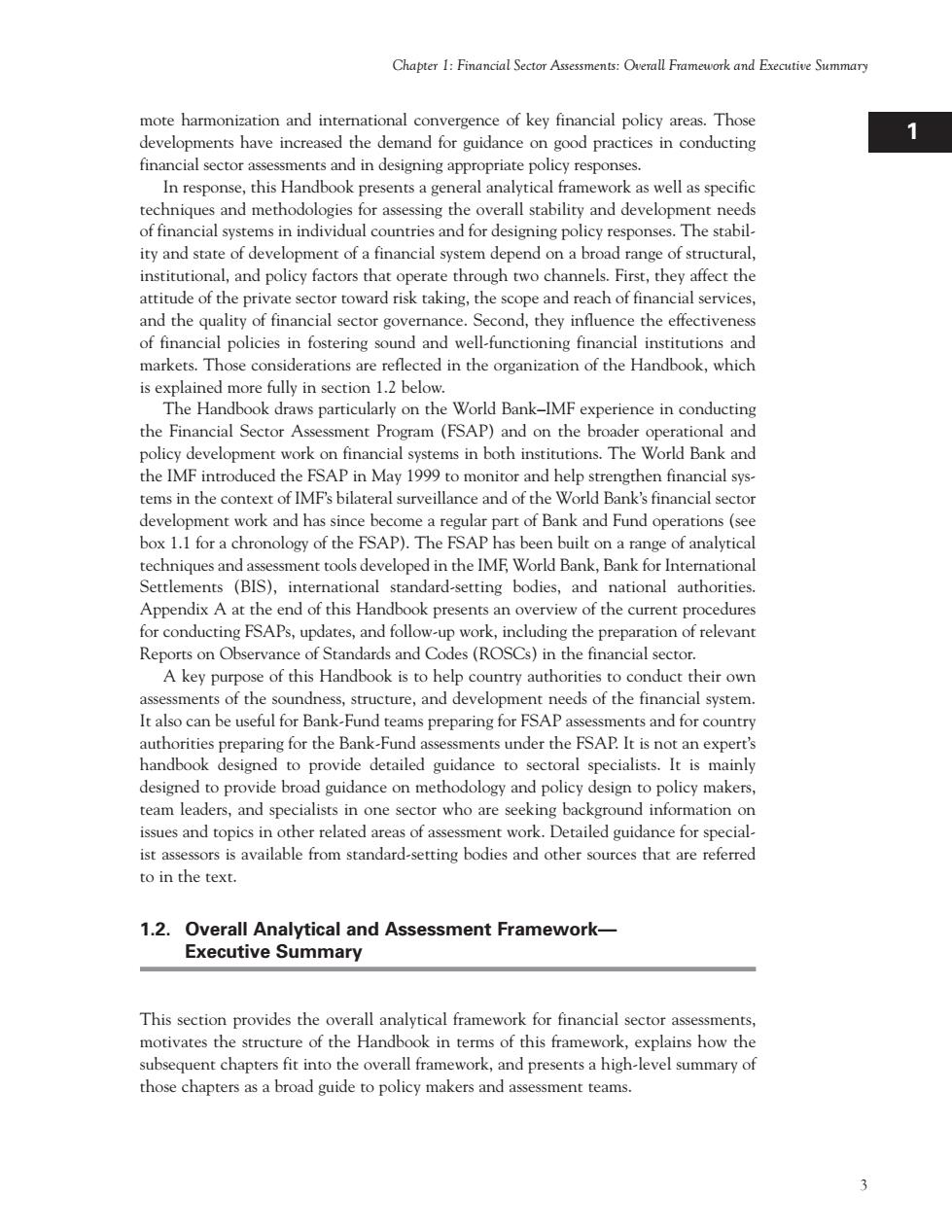正在加载图片...

Chapter 1:Fimancial Sector Assessments:Overall Framework and Executive Summary mote harmonization and international con nce of key financial policy areas.Thos nents have increased the demand for guidance on good practices in conducting 1 financial sector as ments and in designing appropriate policy responses. In response,this Handbook presents a general analytical framework as well as specific techniques and methodologies for assessing the overall stability and development needs of financial systems in individual countries and for designing policy responses.The stabil- ity and state of development of a financial system depend on a broad range of structural institutional,and policy factors that operate through two channels.First,they affect the toward risk taking. and reach of fina cial service nce Second,they inluence the effectivene -functioning financia markets.Those considerations are reflected in the organization of the Handbook,which is explained more fully in section 1.2 below. The Handbook draws particularly on the World Bank-IMF experience in conducting the Financial Sector Assessment Program(FSAP)and on the broader operational and policy development work on financial systems in both institutions.The World Bank and the IME in oduced the esap in may 1999 to gthen fina tems in the conte tof IMFs bilateral surveill and heln nce and of the We development work and has since become a regular part of Bank and Fund operations(se box 1.I for a chronology of the FSAP).The FSAP has been built on a range of analytica techniques and assessment tools developed in the IMF,World Bank,Bank for International Settlements (BIS).international standard-setting bodies.and national authorities Appendix A at the end of this Handbook presents an overview of the current procedures for on Ob of Standards and Codes (ROSCs)in the fin cial se A key purpo e of this Handbook is to he o country author es co their owr ssessments of the soundness s,structure,and development needs of the financial system It also can be useful for Bank-Fund teams preparing for FSAP assessments and for country authorities preparing for the Bank-Fund assessments under the FSAP.It is not an expert's handbook designed to provide detailed guidance to sectoral specialists.It is mainly designed to provide broad guidance on methodology and policy design to policy makers team leaders,and specialists in one sector who are seeking background information on issues and topics in her related a of ass cial savailable ork Detailed guidance for spe dies and other sources that are referrec to in the text. 1.2.Overall Analytical and Assessment Framework- Executive Summary This provides the overall analytical framework for financial otivates the ains how subsequent chapters fit into the overall framework,and presents a high-level summary of those chapters as a broad guide to policy makers and assessment teams. 3 Chapter 1: Financial Sector Assessments: Overall Framework and Executive Summary 1 I H G F E D C B A 12 11 10 9 8 7 6 5 4 3 2 mote harmonization and international convergence of key financial policy areas. Those developments have increased the demand for guidance on good practices in conducting financial sector assessments and in designing appropriate policy responses. In response, this Handbook presents a general analytical framework as well as specific techniques and methodologies for assessing the overall stability and development needs of financial systems in individual countries and for designing policy responses. The stability and state of development of a financial system depend on a broad range of structural, institutional, and policy factors that operate through two channels. First, they affect the attitude of the private sector toward risk taking, the scope and reach of financial services, and the quality of financial sector governance. Second, they influence the effectiveness of financial policies in fostering sound and well-functioning financial institutions and markets. Those considerations are reflected in the organization of the Handbook, which is explained more fully in section 1.2 below. The Handbook draws particularly on the World Bank–IMF experience in conducting the Financial Sector Assessment Program (FSAP) and on the broader operational and policy development work on financial systems in both institutions. The World Bank and the IMF introduced the FSAP in May 1999 to monitor and help strengthen financial systems in the context of IMF’s bilateral surveillance and of the World Bank’s financial sector development work and has since become a regular part of Bank and Fund operations (see box 1.1 for a chronology of the FSAP). The FSAP has been built on a range of analytical techniques and assessment tools developed in the IMF, World Bank, Bank for International Settlements (BIS), international standard-setting bodies, and national authorities. Appendix A at the end of this Handbook presents an overview of the current procedures for conducting FSAPs, updates, and follow-up work, including the preparation of relevant Reports on Observance of Standards and Codes (ROSCs) in the financial sector. A key purpose of this Handbook is to help country authorities to conduct their own assessments of the soundness, structure, and development needs of the financial system. It also can be useful for Bank-Fund teams preparing for FSAP assessments and for country authorities preparing for the Bank-Fund assessments under the FSAP. It is not an expert’s handbook designed to provide detailed guidance to sectoral specialists. It is mainly designed to provide broad guidance on methodology and policy design to policy makers, team leaders, and specialists in one sector who are seeking background information on issues and topics in other related areas of assessment work. Detailed guidance for specialist assessors is available from standard-setting bodies and other sources that are referred to in the text. 1.2. Overall Analytical and Assessment Framework— Executive Summary This section provides the overall analytical framework for financial sector assessments, motivates the structure of the Handbook in terms of this framework, explains how the subsequent chapters fit into the overall framework, and presents a high-level summary of those chapters as a broad guide to policy makers and assessment teams